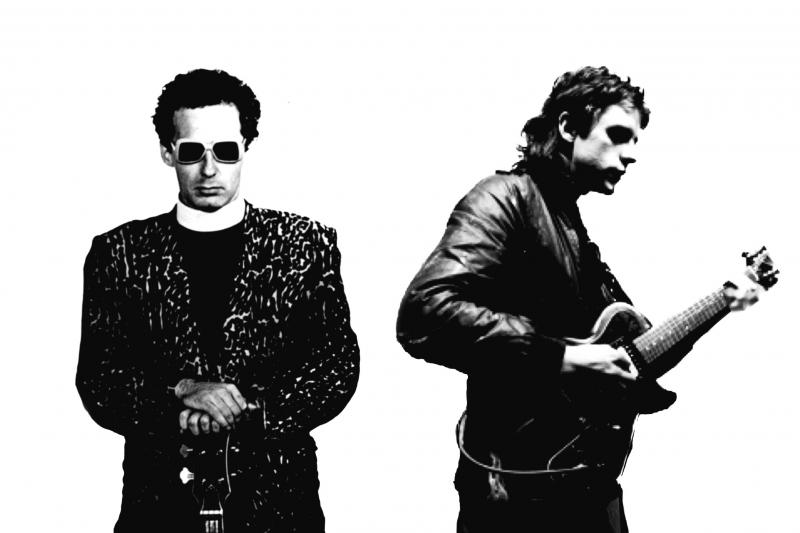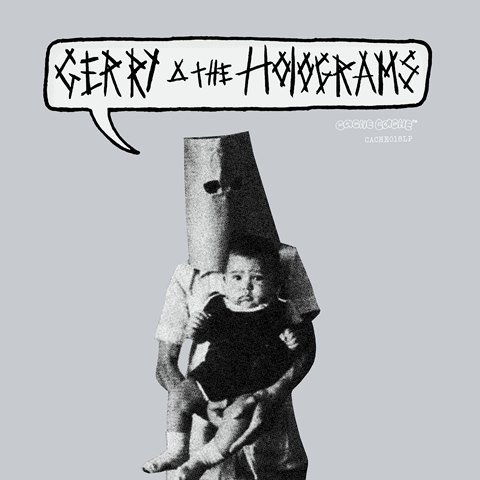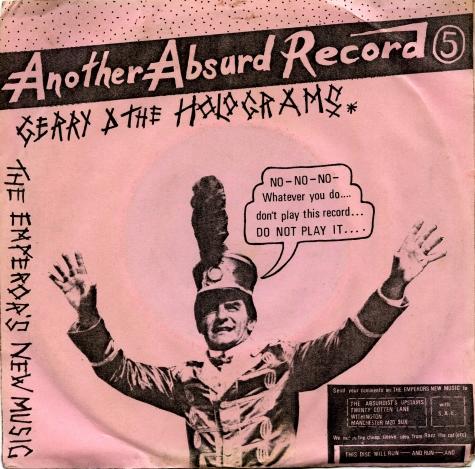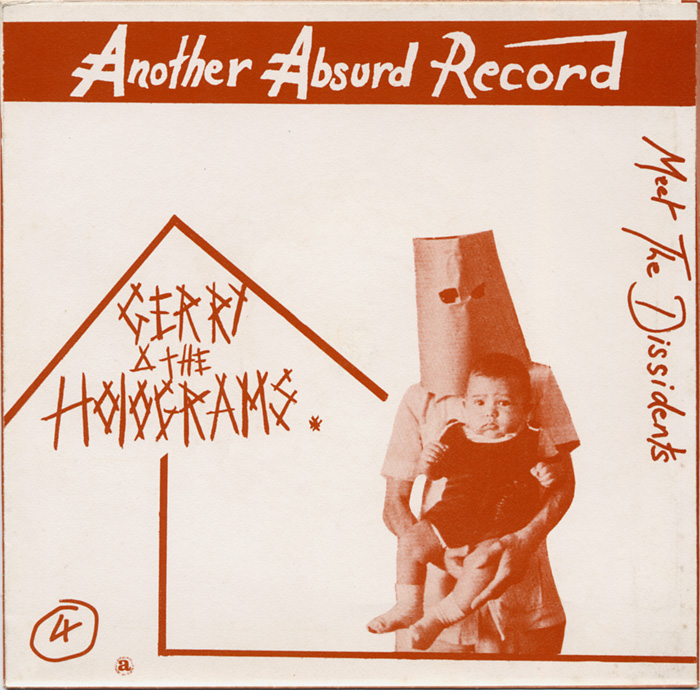Reissue CDs Weekly: Gerry & The Holograms | reviews, news & interviews
Reissue CDs Weekly: Gerry & The Holograms
Reissue CDs Weekly: Gerry & The Holograms
Did an obscure Manchester electronic duo influence New Order?

It’s been suggested that New Order’s “Blue Monday” borrowed from Gerry & The Holograms’ eponymous 1979 A-side.
Yet, the track’s synthesised walking rhythm and vocal line – though treated to sound like a singing Dalek – do suggest those of “Blue Monday”. But until New Order are directly asked about the ostensible connection, this musical chicken and egg conundrum will remain unresolved.
 Nonetheless, the liner notes of a new Gerry & The Holograms compilation quote the duo’s John Scott as saying, "Hundreds of people have asked how I feel about New Order appropriating our music. Unless I won the lottery I couldn't afford to fight the battle. It's a David versus Goliath situation to be honest. I can’t afford to have an opinion."
Nonetheless, the liner notes of a new Gerry & The Holograms compilation quote the duo’s John Scott as saying, "Hundreds of people have asked how I feel about New Order appropriating our music. Unless I won the lottery I couldn't afford to fight the battle. It's a David versus Goliath situation to be honest. I can’t afford to have an opinion."
The chance to hear the – undeniably – obscure though seemingly influential Gerry & The Holograms afresh comes with the release of Return of the Dissidents: The Fractional Crystallisation of Gerry & The Holograms an 11-track collection of this peculiar outfit’s musical offerings. Bar the A-side and its flip “Increased Resistance”, almost everything is previously unissued (the liner notes say Scott released “Space Invaders” under another unidentified pseudonym).
Return of the Dissidents also includes never-heard follow-up single to "Gerry & The Holograms", “The Emperor’s New Music” (pictured below left). When it reached shops, the record was glued to the inside of its sleeve and therefore destined never to be placed on a turntable. This review will not spoil the surprise of finally learning what the formerly unplayable “The Emperor’s New Music” actually sounds like.
Before the release of Return of The Dissidents, interest in Gerry & The Holograms was not limited to the purported influence on New Order. Frank Zappa had played “Gerry & The Holograms” on BBC Radio 1’s Star Special in January 1980. He also span the single while DJing at New York’s Mudd Club.
 The object of Zappa's interest was a studio-only duo formed by Scott and C.P. Lee. The latter was the prime mover in Manchester satire-rock band Alberto Y Los Trios Paranoias who, since 1976, had been issuing records lampooning the film Jaws, Elvis Presley, punk rock and Status Quo’s boogie music. Scott was from Liverpool, Manchester based and first hit vinyl when he created the music for John Cooper Clarke’s first EP in 1977. The next year, he did the same with the Jilted John single. Both those were on the indie label Rabid. Absurd was started by some of those already involved in Rabid for music which was avowedly hard to market.
The object of Zappa's interest was a studio-only duo formed by Scott and C.P. Lee. The latter was the prime mover in Manchester satire-rock band Alberto Y Los Trios Paranoias who, since 1976, had been issuing records lampooning the film Jaws, Elvis Presley, punk rock and Status Quo’s boogie music. Scott was from Liverpool, Manchester based and first hit vinyl when he created the music for John Cooper Clarke’s first EP in 1977. The next year, he did the same with the Jilted John single. Both those were on the indie label Rabid. Absurd was started by some of those already involved in Rabid for music which was avowedly hard to market.
Lee had dealt in reconfiguring the conventional, so landing at Absurd initially seems odd but two of his fellow Albertos formed the experimental Mothmen: confirmation of a hitherto untapped exploratory side to their earlier band. With Gerry & The Holograms, Lee and Scott created a unit fully in line with the bizarre Absurd roster which also included the Throbbing Gristle-like Blah Blah Blah and the dub/African music-inspired Mothmen. Everything on the label is collectable. Copies of the original “Gerry & The Holograms” single in its Meet the Dissidents-branded sleeve sell for £80 to £150 (pictured below right).
 Most of Return of The Dissidents is instrumental. Lee’s vocals were limited to the single. This means the compilation is more one of The Holograms as Gerry is missing in action. Nonetheless, what’s collected reveals Scott as fond of bubbling, kinetic rhythm machine-driven, Yellow Magic Orchestra-esque instrumentals which would have suited the soundtracks for documentaries on science: music to accompany images of test tubes bubbling or graphics of cells multiplying. All terrific stuff, it points to Scott’s future work for television and film soundtracks which supplemented his main job as a studio engineer. He created the music for an episode of Count Duckula.
Most of Return of The Dissidents is instrumental. Lee’s vocals were limited to the single. This means the compilation is more one of The Holograms as Gerry is missing in action. Nonetheless, what’s collected reveals Scott as fond of bubbling, kinetic rhythm machine-driven, Yellow Magic Orchestra-esque instrumentals which would have suited the soundtracks for documentaries on science: music to accompany images of test tubes bubbling or graphics of cells multiplying. All terrific stuff, it points to Scott’s future work for television and film soundtracks which supplemented his main job as a studio engineer. He created the music for an episode of Count Duckula.
Return of The Dissidents is a little frustrating as it is sloppily billed as a “Complete Unreleased LP” from 1979 and also annotated as collecting a series of tracks taped from 1979 to 1983: the latter is more likely to be the case. The recording date of a more “Blue Monday”-like alternate “Gerry & The Holograms” with added rhythm machine is not given. Indeed, no specific dates are noted. Knowing these would be useful. And “Ha Ha Said the Clones” (originally mooted as a Pete Shelley produced Albertos single), a Gerry & The Holograms single announced in the music press for a January 1980 release, is not included and not mentioned in the liner notes.
Despite the reservations, the vinyl-only Return of The Dissidents: The Fractional Crystallisation of Gerry & The Holograms plugs a gap in the story of Manchester's music by disinterring an assemblage of previously unheard gems. It also brings the curious an opportunity to make their own minds up about whether New Order were – or were not – listening to Gerry & The Holograms.
Explore topics
Share this article
Add comment
The future of Arts Journalism
You can stop theartsdesk.com closing!
We urgently need financing to survive. Our fundraising drive has thus far raised £49,000 but we need to reach £100,000 or we will be forced to close. Please contribute here: https://gofund.me/c3f6033d
And if you can forward this information to anyone who might assist, we’d be grateful.

Subscribe to theartsdesk.com
Thank you for continuing to read our work on theartsdesk.com. For unlimited access to every article in its entirety, including our archive of more than 15,000 pieces, we're asking for £5 per month or £40 per year. We feel it's a very good deal, and hope you do too.
To take a subscription now simply click here.
And if you're looking for that extra gift for a friend or family member, why not treat them to a theartsdesk.com gift subscription?
more New music
 Moroccan Gnawa comes to Manhattan with 'Saha Gnawa'
Trance and tradition meet Afrofuturism in Manhattan
Moroccan Gnawa comes to Manhattan with 'Saha Gnawa'
Trance and tradition meet Afrofuturism in Manhattan
 Soulwax’s 'All Systems Are Lying' lays down some tasty yet gritty electro-pop
Belgian dancefloor veterans return to the fray with a dark, pop-orientated sound
Soulwax’s 'All Systems Are Lying' lays down some tasty yet gritty electro-pop
Belgian dancefloor veterans return to the fray with a dark, pop-orientated sound
 Music Reissues Weekly: Marc and the Mambas - Three Black Nights Of Little Black Bites
When Marc Almond took time out from Soft Cell
Music Reissues Weekly: Marc and the Mambas - Three Black Nights Of Little Black Bites
When Marc Almond took time out from Soft Cell
 Album: Mobb Deep - Infinite
A solid tribute to a legendary history
Album: Mobb Deep - Infinite
A solid tribute to a legendary history
 Album: Boz Scaggs - Detour
Smooth and soulful standards from an old pro
Album: Boz Scaggs - Detour
Smooth and soulful standards from an old pro
 Emily A. Sprague realises a Japanese dream on 'Cloud Time'
A set of live improvisations that drift in and out of real beauty
Emily A. Sprague realises a Japanese dream on 'Cloud Time'
A set of live improvisations that drift in and out of real beauty
 Trio Da Kali, Milton Court review - Mali masters make the ancient new
Three supreme musicians from Bamako in transcendent mood
Trio Da Kali, Milton Court review - Mali masters make the ancient new
Three supreme musicians from Bamako in transcendent mood
 Hollie Cook's 'Shy Girl' isn't heavyweight but has a summery reggae lilt
Tropical-tinted downtempo pop that's likeable if uneventful
Hollie Cook's 'Shy Girl' isn't heavyweight but has a summery reggae lilt
Tropical-tinted downtempo pop that's likeable if uneventful
 Pop Will Eat Itself's 'Delete Everything' is noisy but patchy
Despite unlovely production, the Eighties/Nineties unit retain rowdy ebullience
Pop Will Eat Itself's 'Delete Everything' is noisy but patchy
Despite unlovely production, the Eighties/Nineties unit retain rowdy ebullience
 Music Reissues Weekly: The Earlies - These Were The Earlies
Lancashire and Texas unite to fashion a 2004 landmark of modern psychedelia
Music Reissues Weekly: The Earlies - These Were The Earlies
Lancashire and Texas unite to fashion a 2004 landmark of modern psychedelia
 Odd times and clunking lines in 'The Life of a Showgirl' for Taylor Swift
A record this weird should be more interesting, surely
Odd times and clunking lines in 'The Life of a Showgirl' for Taylor Swift
A record this weird should be more interesting, surely

Comments
First heard Blue Monday when